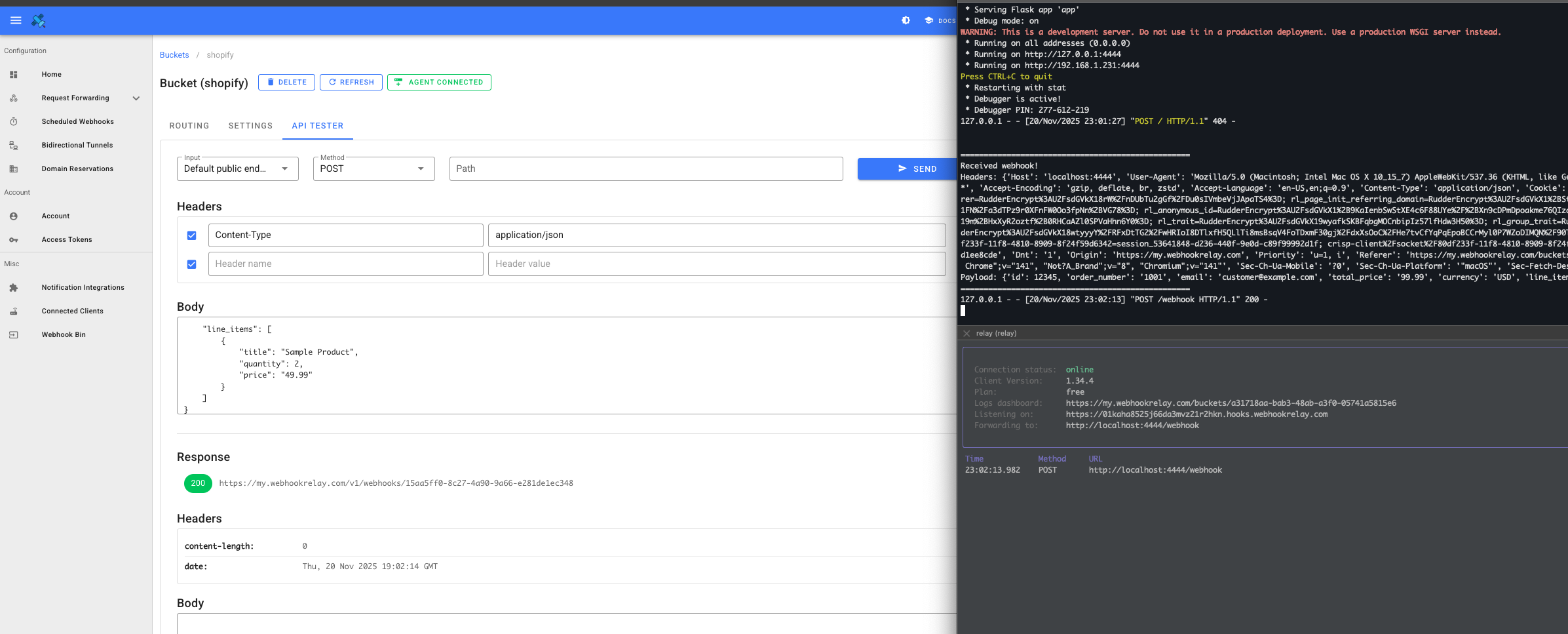Receive Shopify webhooks on Flask API
A short tutorial on how to configure and receive webhooks on your Flask API
In this tutorial, we will configure a Flask API to receive webhooks using Webhook Relay. This allows you to receive webhooks even when your Flask application is running locally or behind a firewall.
Prerequisites
- A Webhook Relay account (sign up here)
- Python 3.8+ installed
- Webhook Relay CLI installed (installation guide)
Step 1: Install Flask with uv
First, let's set up a new Python project and install Flask using uv, a fast Python package installer:
# Install uv if you haven't already
curl -LsSf https://astral.sh/uv/install.sh | sh
# Create a new project directory
mkdir flask-webhook-server
cd flask-webhook-server
# Create a virtual environment and install Flask
uv venv
source .venv/bin/activate # On Windows: .venv\Scripts\activate
uv pip install flask
Step 2: Create the Flask Application
Create a file named app.py with the following content:
from flask import Flask, request, jsonify
app = Flask(__name__)
@app.route('/webhook', methods=['POST'])
def webhook():
data = request.get_json()
headers = dict(request.headers)
print("=" * 50)
print("Received webhook!")
print(f"Headers: {headers}")
print(f"Payload: {data}")
print("=" * 50)
return jsonify({"status": "received", "message": "Webhook processed successfully"}), 200
if __name__ == '__main__':
app.run(host='0.0.0.0', port=4444, debug=True)
This simple Flask application:
- Listens on port 4444
- Accepts POST requests at
/webhook - Logs the headers and payload to the console
- Returns a success response
Step 3: Start the Flask Server
Run your Flask application:
python app.py
You should see output indicating the server is running:
* Running on http://0.0.0.0:4444
Step 4: Set up Webhook Relay Forwarding
In a new terminal window, authenticate with Webhook Relay and start forwarding webhooks:
# Login to Webhook Relay (get your token from https://my.webhookrelay.com/tokens)
relay login -k your-token-key -s your-token-secret
# Start forwarding webhooks to your Flask server
relay forward -b shopify-webhooks http://localhost:4444/webhook
You'll see output like:
Forwarding:
https://xxx.hooks.webhookrelay.com -> http://localhost:4444/webhook
Starting webhook relay agent...
Copy the public URL (e.g., https://xxx.hooks.webhookrelay.com) - this is where webhooks will be sent.
Step 5: Test with a Sample Webhook
Now let's send a test webhook to your Flask server using curl:
curl -X POST https://xxx.hooks.webhookrelay.com \
-H "Content-Type: application/json" \
-H "X-Shopify-Topic: orders/create" \
-d '{
"id": 12345,
"order_number": "1001",
"email": "[email protected]",
"total_price": "99.99",
"currency": "USD",
"line_items": [
{
"title": "Sample Product",
"quantity": 2,
"price": "49.99"
}
]
}'
Or use the Webhook Relay UI to send a test webhook:

In your Flask server terminal, you should see the webhook logged:
==================================================
Received webhook!
Headers: {'Host': 'localhost:4444', 'Content-Type': 'application/json', 'X-Shopify-Topic': 'orders/create', ...}
Payload: {'id': 12345, 'order_number': '1001', 'email': '[email protected]', ...}
==================================================
Next Steps
Now that your Flask server is receiving webhooks, you can:
- Process webhook data (save to database, trigger actions, etc.)
- Verify webhook signatures for security
- Handle different webhook types based on headers
- Deploy your Flask app and update the forwarding URL
For production deployments, consider using a process manager like gunicorn and running the Webhook Relay agent as a system service. Check out our installation guide with Docker or Kubernetes for more details.

